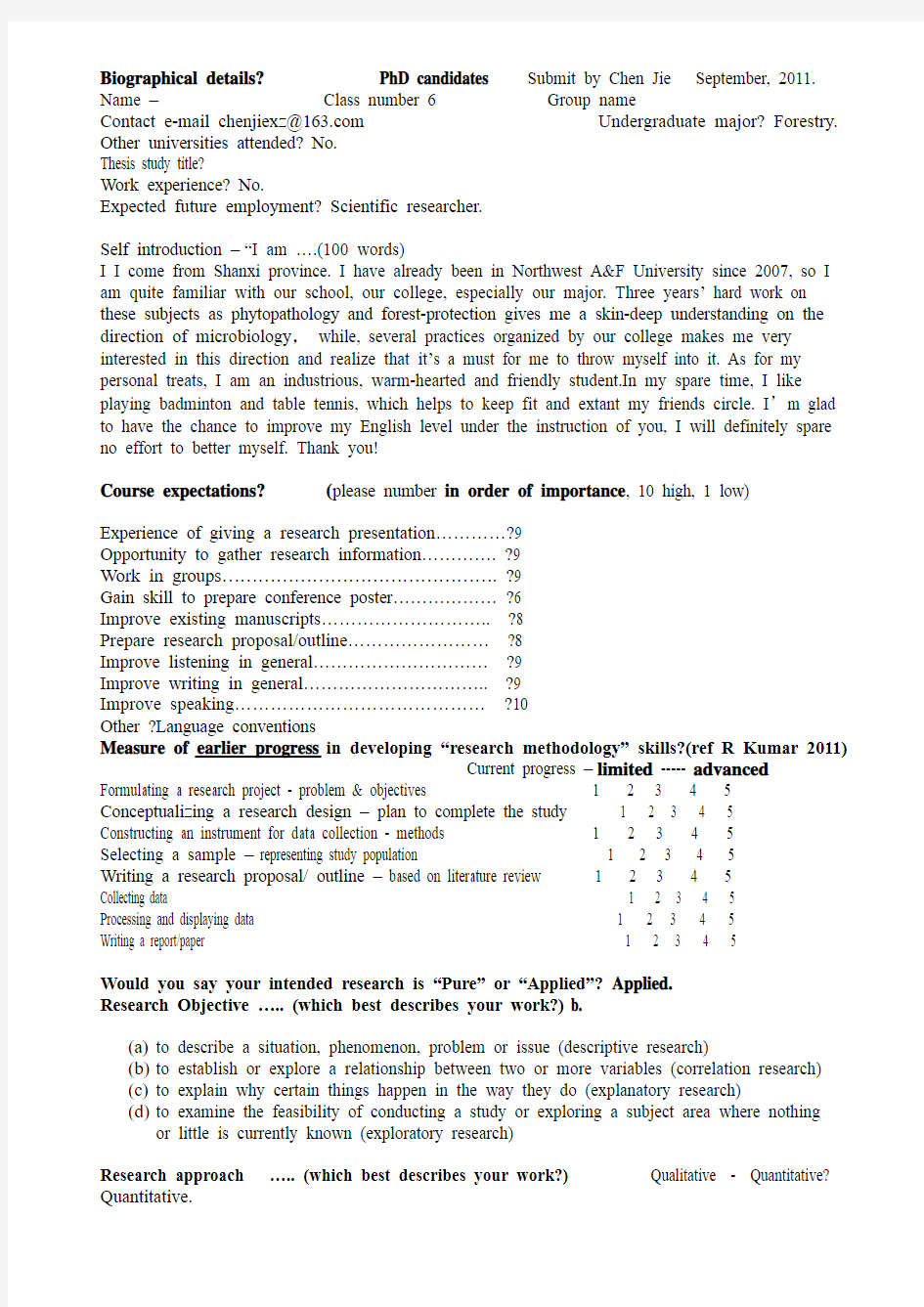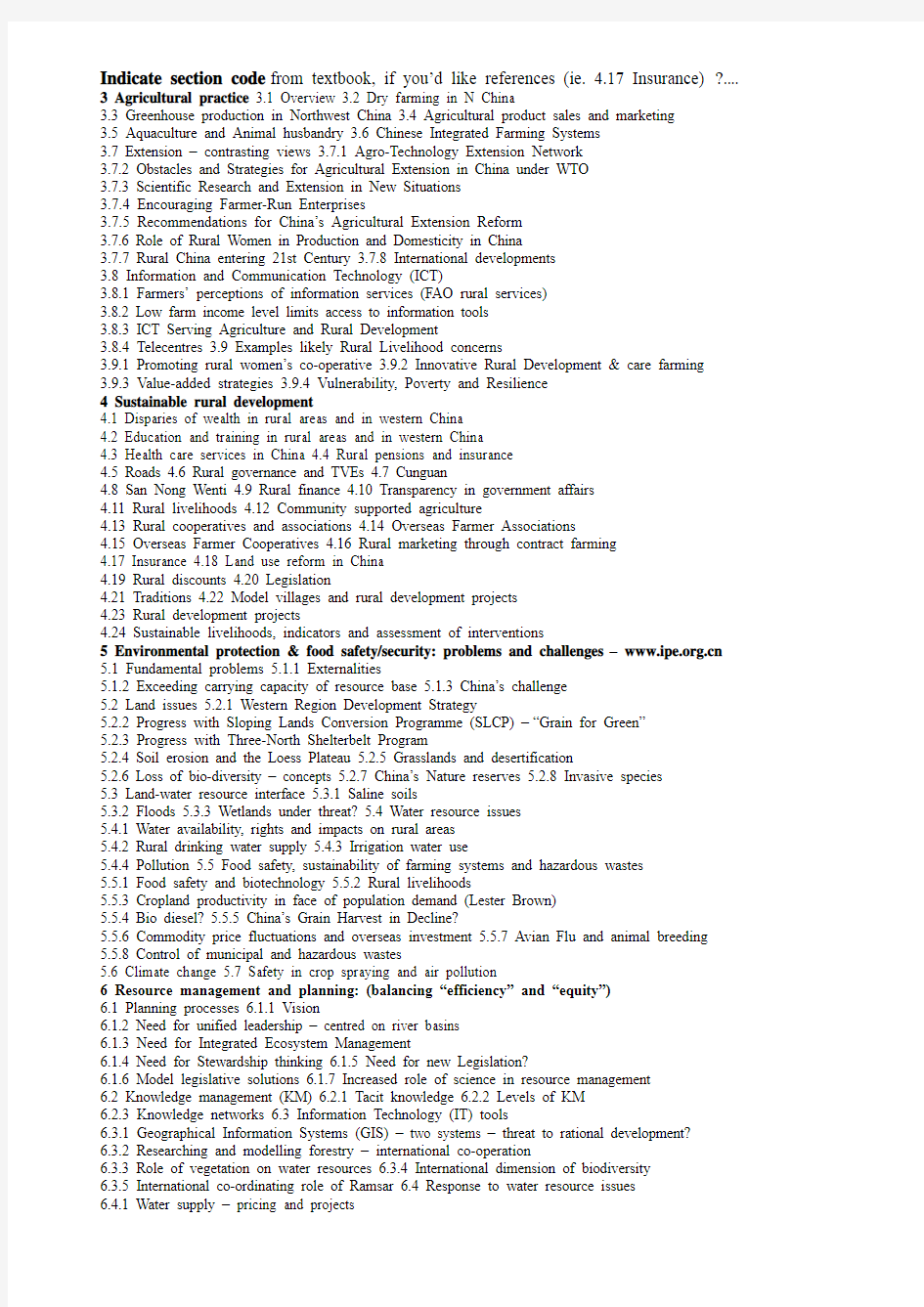

Biographical details? PhD candidates Submit by Chen Jie September, 2011. Name –Class number 6 Group name
Contact e-mail chenjiexz@https://www.doczj.com/doc/2514950946.html, Undergraduate major? Forestry. Other universities attended? No.
Thesis study title?
Work experience? No.
Expected future employment? Scientific researcher.
Self introduction –“I am ….(100 words)
I I come from Shanxi province. I have already been in Northwest A&F University since 2007, so I am quite familiar with our school, our college, especially our major. Three years’ hard work on these subjects as phytopathology and forest-protection gives me a skin-deep understanding on the direction of microbiology, while, several practices organized by our college makes me very interested in this direction and realize that it’s a must for me to throw myself into it. As for my personal treats, I am an industrious, warm-hearted and friendly student.In my spare time, I like playing badminton and table tennis, which helps to keep fit and extant my friends circle. I’m glad to have the chance to improve my English level under the instruction of you, I will definitely spare no effort to better myself. Thank you!
Course expectations? (please number in order of importance, 10 high, 1 low) Experience of gi ving a research presentation…………?9
Opportunity to gather research information…………. ?9
Work in groups………………………………………. ?9
Gain skill to prepare conference poster……………… ?6
Improve existing manuscripts……………………….. ?8
Prepare research proposal/outline…………………… ?8
Improve listening in general………………………… ?9
Improve writing in general………………………….. ?9
Improve speaking…………………………………… ?10
Other ?Language conventions
Measure of earlier progress in developing “research methodology” skills?(ref R Kumar 2011)
Current progress –limited ----- advanced Formulating a research project - problem & objectives 1 2 3 4 5 Conceptualizing a research design – plan to complete the study 1 2 3 4 5 Constructing an instrument for data collection - methods 1 2 3 4 5
Selecting a sample – representing study population 1 2 3 4 5
Writing a research proposal/ outline – based on literature review 1 2 3 4 5
Collecting data 1 2 3 4 5 Processing and displaying data 1 2 3 4 5
Writing a report/paper 1 2 3 4 5
Would you say your intended research is “Pure” or “Applied”? Applied.
Research Objective ….. (which best describes your work?) b.
(a)to describe a situation, phenomenon, problem or issue (descriptive research)
(b)to establish or explore a relationship between two or more variables (correlation research)
(c)to explain why certain things happen in the way they do (explanatory research)
(d)to examine the feasibility of conducting a study or exploring a subject area where nothing
or little is currently known (exploratory research)
Research approach ….. (which best describes your work?) Qualitative - Quantitative? Quantitative.
Indicate section code from textbook, if you’d like references (ie. 4.17 Insurance) ?....
3 Agricultural practice 3.1 Overview 3.2 Dry farming in N China
3.3 Greenhouse production in Northwest China 3.4 Agricultural product sales and marketing
3.5 Aquaculture and Animal husbandry 3.6 Chinese Integrated Farming Systems
3.7 Extension – contrasting views 3.7.1 Agro-Technology Extension Network
3.7.2 Obstacles and Strategies for Agricultural Extension in China under WTO
3.7.3 Scientific Research and Extension in New Situations
3.7.4 Encouraging Farmer-Run Enterprises
3.7.5 Recommendations for China’s Agricultural Extension Reform
3.7.6 Role of Rural Women in Production and Domesticity in China
3.7.7 Rural China entering 21st Century 3.7.8 International developments
3.8 Information and Communication Technology (ICT)
3.8.1 Farmers’ perceptions of information services (FAO rural services)
3.8.2 Low farm income level limits access to information tools
3.8.3 ICT Serving Agriculture and Rural Development
3.8.4 Telecentres 3.9 Examples likely Rural Livelihood concerns
3.9.1 Promoting rural women’s co-operative 3.9.2 Innovative Rural Development & care farming
3.9.3 Value-added strategies 3.9.4 Vulnerability, Poverty and Resilience
4 Sustainable rural development
4.1 Disparies of wealth in rural areas and in western China
4.2 Education and training in rural areas and in western China
4.3 Health care services in China 4.4 Rural pensions and insurance
4.5 Roads 4.6 Rural governance and TVEs 4.7 Cunguan
4.8 San Nong Wenti 4.9 Rural finance 4.10 Transparency in government affairs
4.11 Rural livelihoods 4.12 Community supported agriculture
4.13 Rural cooperatives and associations 4.14 Overseas Farmer Associations
4.15 Overseas Farmer Cooperatives 4.16 Rural marketing through contract farming
4.17 Insurance 4.18 Land use reform in China
4.19 Rural discounts 4.20 Legislation
4.21 Traditions 4.22 Model villages and rural development projects
4.23 Rural development projects
4.24 Sustainable livelihoods, indicators and assessment of interventions
5 Environmental protection & food safety/security: problems and challenges – https://www.doczj.com/doc/2514950946.html, 5.1 Fundamental problems 5.1.1 Externalities
5.1.2 Exceeding carrying capacity of resource base 5.1.3 China’s challenge
5.2 Land issues 5.2.1 Western Region Development Strategy
5.2.2 Progress with Sloping Lands Conversion Programme (SLCP) –“Grain for Green”
5.2.3 Progress with Three-North Shelterbelt Program
5.2.4 Soil erosion and the Loess Plateau 5.2.5 Grasslands and desertification
5.2.6 Loss of bio-diversity – concepts 5.2.7 China’s Nature reserves 5.2.8 Invasive species
5.3 Land-water resource interface 5.3.1 Saline soils
5.3.2 Floods 5.3.3 Wetlands under threat? 5.4 Water resource issues
5.4.1 Water availability, rights and impacts on rural areas
5.4.2 Rural drinking water supply 5.4.3 Irrigation water use
5.4.4 Pollution 5.5 Food safety, sustainability of farming systems and hazardous wastes
5.5.1 Food safety and biotechnology 5.5.2 Rural livelihoods
5.5.3 Cropland productivity in face of population demand (Lester Brown)
5.5.4 Bio diesel? 5.5.5 China’s Grain Harvest in Decline?
5.5.6 Commodity price fluctuations and overseas investment 5.5.7 Avian Flu and animal breeding
5.5.8 Control of municipal and hazardous wastes
5.6 Climate change 5.7 Safety in crop spraying and air pollution
6 Resource management and planning: (balancing “efficiency” and “equity”)
6.1 Planning processes 6.1.1 Vision
6.1.2 Need for unified leadership – centred on river basins
6.1.3 Need for Integrated Ecosystem Management
6.1.4 Need for Stewardship thinking 6.1.5 Need for new Legislation?
6.1.6 Model legislative solutions 6.1.7 Increased role of science in resource management
6.2 Knowledge management (KM) 6.2.1 Tacit knowledge 6.2.2 Levels of KM
6.2.3 Knowledge networks 6.3 Information Technology (IT) tools
6.3.1 Geographical Information Systems (GIS) – two systems – threat to rational development?
6.3.2 Researching and modelling forestry – international co-operation
6.3.3 Role of vegetation on water resources 6.3.4 International dimension of biodiversity
6.3.5 International co-ordinating role of Ramsar 6.4 Response to water resource issues
6.4.1 Water supply – pricing and projects
6.4.2 Key drinking water technologies, international debate and new water supplies
6.4.3 Water rights 6.4.4 Water Harvesting
6.4.5 Improved irrigation water productivity 6.4.6 Water resource management software 6.5 Improving fertilizer efficiency?
6.6 Pollution prevention and full evaluation of wastewater treatment technologies.
6.6.1 Polluter pays 6.6.2 Wastewater treatment facilities
6.6.3 Industrial waste water technologies
6.6.4 Urban Wastewater technologies and municipal waste
6.6.5 Appropriate Technology? 6.6.6 Ecological Engineering
6.6.7 Anaerobic Treatment Systems 6.6.8 Soil Aquifer Treatment
6.6.9 Wetland treatments (tertiary) 6.6.10 Irrigating trees
6.6.11 Overland flow systems 6.7 Wetlands to protect biodiversity
6. 8 Improved water recycling 6.8.1 Challenges
6.8.2 Re-use in China 6.8.3 Re-use in Europe
6.8.4 Re-use in Australia (Queensland)
6.8.5 Re-use in the United States 6.9 Agricultural planning and management
6.9.1 In China and India
6.9.2 International Digital libraries and Agricultural Research Information System (ARIS) 6.9.3 Australian ICT in rural economy 6.9.4 European ICT in rural economy
6.9.5 Marketing and accounting software 6.9.6 Crop planning
6.9.6 Fertiliser management/ weed control
6.9.7 Irrigation scheduling and land drainage
6.9.8 Wastewater spreading and farm wastes management
6.9.9 Crop Disease forecasting 6.9.10 Feed formulation and rationing
6.9.11 Whole farm planning and scenario analysis 6.10 Invasive species
6.11 1ntegrated Pest Management (IPM) 6.12 Avian Flu
6.13 Renewable energy 6.13.1 Pledge
6.13.2 Driving force behind the development of renewable energy in China
6.13.3 Priority areas for developing the renewable energy and development goals in China 6.13.4 Demonstration projects 6.13.5 Financing 6.13.6 Progress
6.14 Climate change and food security